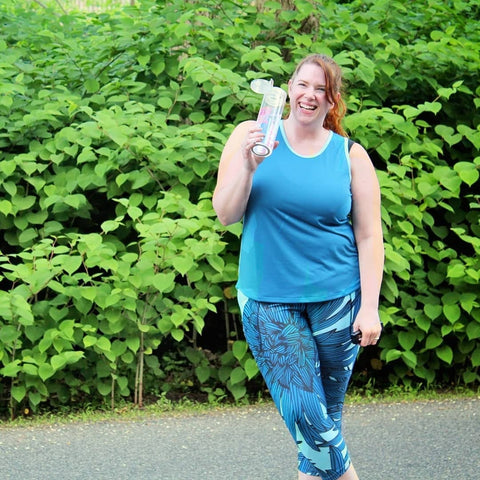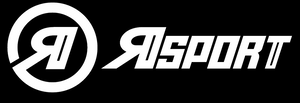About Us
Our vision is to create a world where women are lauded for the size of their dreams, and not left out because the size of their body.
Our Mission
Our mission is to remove barriers for Athena athletes by crafting high-quality performance apparel that supports their body in all its variations.
We do this by being the premiere creator, curator, and retailer of Athena apparel and lifestyle products that support women to do what they love.
Our products fuse performance fabrics, advanced technical construction, and refined fit to meet the needs of the Athena athlete in a way no other brand has before.
The Rsport Story

From her early years as a young athlete to her foray into the world of women’s apparel as a teen, CJ Riggins realized there was a serious lack of inclusion for bigger bodies in women’s activewear. As she solidified her career with name-brand activewear companies and continued running and biking on the weekends, CJ realized no one was going to step up and make the changes she wanted. That’s where Rsport was born.
My Early Years
Since I was 12 years old, I knew I would find a career in the world of apparel.
I learned to sew and tat from my aunts. I learned to knit from one grandmother, and quilt from another. And I sketched all the time — especially apparel.
In 8th grade, my best friend coerced me into trying out for the girl’s basketball team — a sport I’d never played in my life. I didn’t make the cut initially, but eked out a spot on the team because one of the athletes was failing and couldn’t play.
“That was my foray into organized athletics: always just on the cusp of acceptance.”

I played basketball the rest of middle school and into high school. I wasn’t a notable player — my only gifts were stealing the ball, getting fouled, and shooting foul shots.
I was already wearing a large basketball uniform, and remember the elastic on the waistband was stretched out and crusty from years of wash, sweat, and wear. There weren’t a lot of other uniforms to swap it with, so I was stuck with this one.

“This is where I first noticed the need for more options for larger bodies, especially in the realm of activewear.”
I entered high school as a size 10/12, and finished high school as a 12/14. Although this was the national average female size in the 80s, it wasn’t comforting that I was “average.”
I was at the top of the size range offered in most apparel stores And like many women in my size range, I was acutely aware of my size — which was made more apparent by every Seventeen Magazine, Vogue, or Elle Magazine I came across.
“Super Models” were the mode du jour, and I didn’t come close in height or girth to what they advertised.
As a freshman in college, I started working for Abercrombie & Fitch. At the time, I wore a 12/14 — right where their size range stopped, and right on the cusp of what was “acceptable.”
The CEO, Michael Jeffries, clearly had a vision of who he did and didn’t want wearing or representing his brand. There was a “Look Book” that described how the ideal employees should dress, along with the groups, schools, and clubs they should belong to.
I asked a technical designer at A&F: “If we know the national average is a 12/14 (as it was the 90’s), why do we still buy to a peak size that is a 6/8?”
His answer? “Because that’s the way they want it.”
That nebulous “they” had reminded me of the wizard behind the curtain in the Wizard of Oz, or something from the movie “Mean Girls.”
Why would you deliberately exclude a population that needs clothing just as much as anyone else?
The Need for Inclusive Athena Activewear

Flash forward to my 30's. 7 days after I started at Pearl Izumi in 2007, they dropped their “Loose Fit” and only ran “Fitted” and “Semi-Fitted.” I noted that “weekend warrior” cyclists liked to wear our shorts and were the bulk of our sales, but skipped over our jerseys because of fit.
In meetings, I shared the fact that the jerseys were too “V” shaped to fit our largest segment of athletes. And I persisted, "Wouldn’t this be a great opportunity to design for the average-sized consumer, since they’re shopping Pearl already?"
The answer wasn’t shocking, but telling: “It would taint the brand”
Running up against this exclusionary perspective always felt like a gut punch. But it was their call — all I could do was ask.
In 2013, Chip Wilson, founder of Lululemon, made a now-famous statement on the morning news circuit when he stated, “Quite frankly, some women’s bodies just actually don’t work (for Lululemon leggings).”
(Cue facepalm emoji).
Rising Up and Making a Change

In the decade after I graduated college, I learned the benefits of running for my physical and mental health. I ran 5K’s to multiple Big Sur marathons, and enjoyed CrossFit and cycling.
I noticed the apparel that was offered for my size — even at the top of the range — was still running snug in the arms, waist, or across the chest. It was clear these garments weren’t truly designed for my size — but for what someone wanted my size to be or look like.

I had every expectation that one of them would launch a segment of an existing brand, or a new brand to serve what I saw was missing. But nothing was changing.
It was like a tickle in the back of my throat that wouldn't go away. The question was “What would I do about it?”
The “it” I’m referring to was the lack of athletic apparel options for the average American woman, who we know today is a 16/18. That includes Plus Size, Athena, and curvy athletes.
What each of these experiences in apparel led me to realize was that no one was coming in to serve the Athena athlete with true performance apparel.
There were plenty of stretchy, short-lived leggings that “looked cool.” But there wasn’t any apparel being designed with quality and attention to the functioning details needed for the Athena, Plus Size, or curvy athlete and her sports endeavors.
For many consumers, the idea of some brands entering the Plus Size market only now — after so many years of not serving Athena athletes — is seen as disingenuous.
We have needs that are different from our straight-sized counterparts. After years of professional experience developing fabrics, trims, patterns, and products, I had finally realized what that tickle was, and how to address it.
Forging My Own Path

After I left the private label team at Belk in 2000, the Director of Private Label Merchandising asked me if anyone had ever shared that the patterning I’d done on my very first project — a basic khaki pant for women — turned the sales around to the largest jump they’d seen since the inception of the product (triple digits).
Those were the types of boosts that told me I knew I could build for the Athena athlete. But to truly serve this customer, I needed to school myself in the areas I was weakest.
I had the design, development, textile, sourcing, and costing side down because I’d been doing it for 20 years. But I still had so much to learn about what wasn’t my expertise yet: financials, sales, and marketing.
I left my position at Pearl Izumi to work for a small startup that needed me to help clean up their costing and waste, their supply chain, and quality with the desire to sell their startup in the coming years.

My request to them, “Teach me what I don’t know about the rest of the business.” And they did: The good, the bad, and the challenging.
The Birth of Rsport

After the sale of the small startup, I felt like I’d already made the Athena athlete wait far too long for something she deserved. But I finally had the experience I needed to feel truly confident to launch a business on my own.
While I was working at the previous startup, I’d relaunched my Master’s Program in Design and Merchandising at Colorado State University (it only took me 15 years to complete!). The Athena athlete and her needs were the focus of my research.
I needed to make sure I wasn’t projecting only a few people’s needs, but that the Athena athlete truly existed and there truly was a viable market.
The market research, anecdotal evidence, and athlete response was telling: The plus-size market was the only portion of the apparel market that was growing. The national average size for women in the USA was a size 16/18, and constituted 67% of the population.
That’s the majority of American women! Europe was only one size smaller, with other countries chasing fast.
And still, no brand was helping this woman meet her needs.

After confirming that the need for Athena and plus size athletic apparel wasn’t a figment of my imagination, I reached out to a long-time friend and factory owner to share my research and wear-test needs. As part of that Master’s research, I wanted a year-long wear test of the most desired products that Athena athletes had asked for, but couldn’t find.
I made prototypes, shipped to volunteer plus-size athletes around the globe, and asked them to share their experiences. I interviewed every athlete near and far (From Colorado to New Zealand, France to Canada) about their experience. I asked very personal questions and took their feedback and converted those comments into action and product.
After listening to all of them, I realized that we — as Athena athletes — had a very low bar for expectations from our apparel. They’d never experienced great apparel that did more than cover their assets. They didn’t know the depth of what these technical fabrics could do for them.
But I knew how to give them what they didn’t know they needed.

All those years in the apparel industry gave me experience, and created invaluable connections and networks that I could draw on for continued mentorship. It gave me mill and factory partners, research, and support.
I presented my research findings to a friend and prior colleague. She was a phenom with numbers, and anything she didn’t know, she could research and figure out in a blink.
I asked her to come on board to help with the launch with her operations and financial background. We began crafting the framework of what would become Rsport.
I also reached out to my network in three specific areas for mentors/sounding boards in marketing, finance, and sales. The three who offered their time, insight, suggestions, and assistance continue to support Rsport today.


Launching in 2017, after two years of research and development (and earning that Master’s degree), Rsport has grown year over year. We continue to find our athletes at running and triathlon events, whose greatness you can witness on Facebook (@rsport_apparel) and Instagram (@rsport_life).
We’ve discovered that our Rsport athletes’ endeavors truly are multisport, and range from hiking, biking, CrossFit, SUP, kayaking, backpacking, yoga, dance, martial arts, etc.
Even in the midst of a global pandemic, when most races and triathlons have been cancelled, we grew by double digits. That told us our athletes needed to keep their sanity by getting outside, to breathe, to live, and to decompress.

And our best form of marketing? Organic word of mouth, from one athlete to another.
As we say, we don’t choose our friends based on their size. We choose our friends based on mutual interests and passions.
That means if you aren’t an Athena or Plus size athlete, you know one. Go tell a friend.



